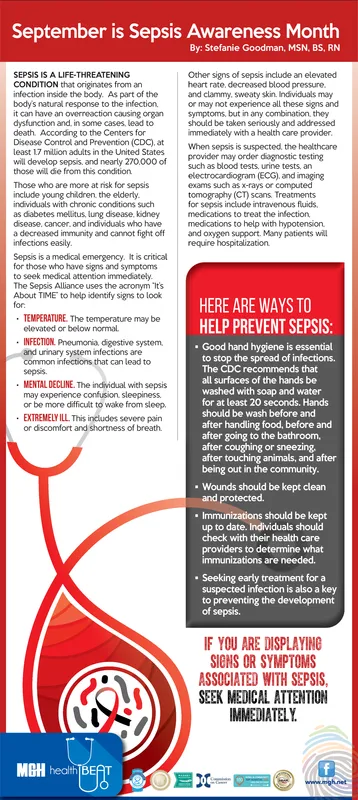Advertisement

-
Published Date
September 12, 2020This ad was originally published on this date and may contain an offer that is no longer valid. To learn more about this business and its most recent offers, click here.
Ad Text
September is Sepsis Awareness Month By: Stefanie Goodman, MSN, BS, RN Other signs of sepsis include an elevated heart rate. decreased blood pressure. and clammy, sweaty skin. Individuals may or may not experience all these signs and symptoms, but in any combination. they should be taken seriously and addressed immediately with a health care provider. SEPSIS IS A LIFE-THREATENING CONDITION that originates from an infection inside the body. As part of the body's natural response to the infection it can have an overreaction causing organ dysfunction and, in some cases. lead to death. According to the Centers for Disease Control and Prevention (CDC), at least 17 million adults in the United States will develop sepsis. and nearly 270.000 of those will die from this condition Those who are more at risk for sepsis include young children. the elderly. individuals with chronic conditions such as diabetes mellitus. lung disease. kidney disease. cancer. and individuals who have a decreased immunity and cannot fight off infections easily. When sepsis is suspected the healthcare provider may order diagnostic testing such as blood tests, urine tests, an electrocardiogram (ECG). and imaging exams such as x-rays or computed tomography (CT) scans. Treatments for sepsis include intravenous fluids. medications to treat the infection medications to help with hypotension. and oxygen support. Many patients will require hospitalization Sepsis is a medical emergency. It is critical for those who have signs and symptoms to seek medical attention immediately. The Sepsis Alliance uses the acronym "It's About TIME to help identify signs to look for: · TEMPERATURE. The temperature may be elevated or below normal. HERE ARE WAYS TO HELP PREVENT SEPSIS: INFECTION. Pneumonia digestive system, and urinary system infections are common infections that can lead to sepsis. MENTAL DECLINE. The individual with sepsis may experience confusion. sleepiness. or be more difficult to wake from sleep. · EXTREMELY ILL. This includes severe pain or discomfort and shortness of breath. Good hand hygiene is essential to stop the spread of infections. The CDC recommends that all surfaces of the hands be washed with soap and water for at least 20 seconds. Hands should be wash before and after handling food, before and after going to the bathroom, after coughing or sneezing. after touching animals, and after being out in the community. - Wounds should be kept clean and protected. Immunizations should be kept up to date. Individuals should check with their health care providers to determine what immunizations are needed. Seeking earty treatment for a suspected infection is also a key to preventing the development of sepsis. IF YOU ARE DISPLAYING SIGNS OR SYMPTOMS ASSOCIATED WITH SEPSIS, SEEK MEDICAL ATTENTION IMMEDIATELY. MGH health BEAT www.mgh.net September is Sepsis Awareness Month By: Stefanie Goodman, MSN, BS, RN Other signs of sepsis include an elevated heart rate. decreased blood pressure. and clammy, sweaty skin. Individuals may or may not experience all these signs and symptoms, but in any combination. they should be taken seriously and addressed immediately with a health care provider. SEPSIS IS A LIFE-THREATENING CONDITION that originates from an infection inside the body. As part of the body's natural response to the infection it can have an overreaction causing organ dysfunction and, in some cases. lead to death. According to the Centers for Disease Control and Prevention (CDC), at least 17 million adults in the United States will develop sepsis. and nearly 270.000 of those will die from this condition Those who are more at risk for sepsis include young children. the elderly. individuals with chronic conditions such as diabetes mellitus. lung disease. kidney disease. cancer. and individuals who have a decreased immunity and cannot fight off infections easily. When sepsis is suspected the healthcare provider may order diagnostic testing such as blood tests, urine tests, an electrocardiogram (ECG). and imaging exams such as x-rays or computed tomography (CT) scans. Treatments for sepsis include intravenous fluids. medications to treat the infection medications to help with hypotension. and oxygen support. Many patients will require hospitalization Sepsis is a medical emergency. It is critical for those who have signs and symptoms to seek medical attention immediately. The Sepsis Alliance uses the acronym "It's About TIME to help identify signs to look for: · TEMPERATURE. The temperature may be elevated or below normal. HERE ARE WAYS TO HELP PREVENT SEPSIS: INFECTION. Pneumonia digestive system, and urinary system infections are common infections that can lead to sepsis. MENTAL DECLINE. The individual with sepsis may experience confusion. sleepiness. or be more difficult to wake from sleep. · EXTREMELY ILL. This includes severe pain or discomfort and shortness of breath. Good hand hygiene is essential to stop the spread of infections. The CDC recommends that all surfaces of the hands be washed with soap and water for at least 20 seconds. Hands should be wash before and after handling food, before and after going to the bathroom, after coughing or sneezing. after touching animals, and after being out in the community. - Wounds should be kept clean and protected. Immunizations should be kept up to date. Individuals should check with their health care providers to determine what immunizations are needed. Seeking earty treatment for a suspected infection is also a key to preventing the development of sepsis. IF YOU ARE DISPLAYING SIGNS OR SYMPTOMS ASSOCIATED WITH SEPSIS, SEEK MEDICAL ATTENTION IMMEDIATELY. MGH health BEAT www.mgh.net
